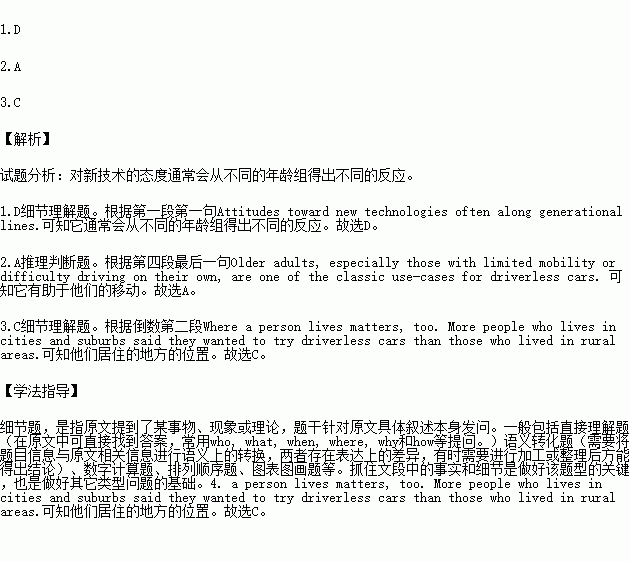题目内容
Attitudes toward new technologies often fall along generational lines. That is, generally, younger people tend to outnumber older people on the front end of a technologic I shift.
It is not always the case, though. When you look at attitudes toward driverless cars y there doesn't seem to be a dear generational divide. The public overall is split on whether they'd like to use a driverless car. In a study last year, of all people surveyed, 48 percent said they wanted to ride in one, while 50 percent did not.
The fact that attitudes toward self-driving cars appear to be so steady across generations suggests how varying the shift to driverless cars could be. Not everyone wants a driverless car now-and no one can get one yet-but among those who are open to them, every age group is similarly involved.
Actually, this isn't surprising. Whereas older generations are sometimes unwilling to adopt new technologies, driverless cars promise real value to these age groups in particular. Older adults, especially those with limited moving or difficulty driving on their own, are one of the classic use-cases for driverless cars.
This is especially interesting when you consider that younger people are generally more interested in travel-related technologies than older ones.
When it comes to driverless cars, differences in attitude are easily noticeable based on factors not related to age. College graduates, for example, are particularly interested in driverless cars compared with those who have less education. 59 percent of college graduates said they would like to use a driverless car compared with 38 percent of those with a high-school diploma or less.
Where a person lives matters, too. More people who live in cities and suburbs said they wanted to try driverless cars than those who lived in rural areas.
While there's reason to believe that interest in 8elf-driving cars is going up across the hoard, a person's age will have little to Ho with how self-driving cars can become mainstream. Once driverless cars are actually available for sale, the early adopters will be the people who can afford to buy them.
1.Which of the following can be the influence of a new technology, according to the passage?
A. It often reads to great inventions in other related fields.
B. It contributes greatly to the advance of society as a whole.
C. It further widens the gap between the old and the young.
D.It usually draws different reactions from different age groups.
2.Why does the driverless car appeal to some old people?
A. It helps with their moving.
B. It saves their money and energy.
C. It adds to the safety of their travel.
D. It makes their life more interesting
3.What is likely to affect one's attitude toward the driverless car?
A. The length of their driving experience.
B. The amount of training they received.
C. The location of their living place.
D. The field of their special interest.
 阅读快车系列答案
阅读快车系列答案
